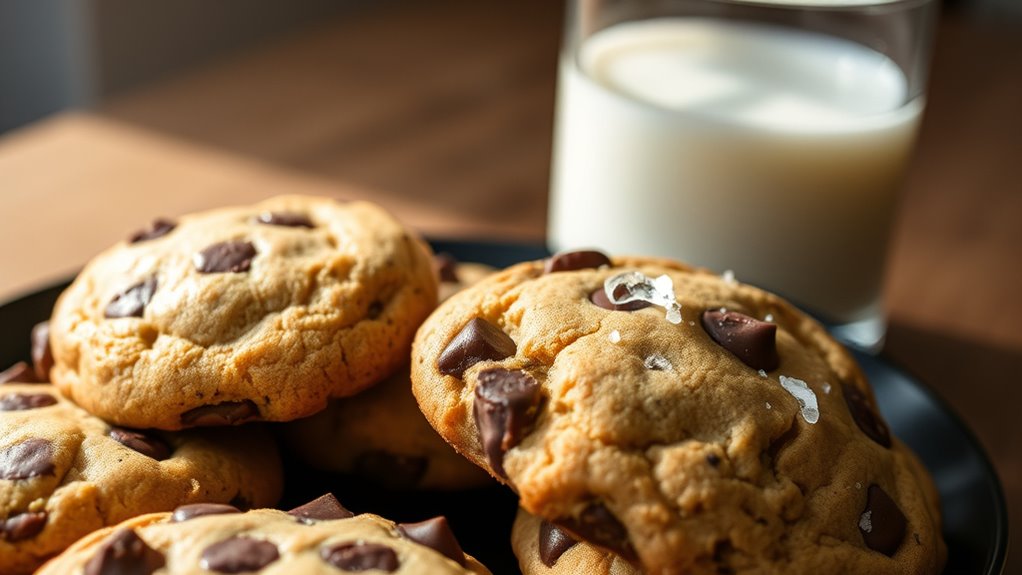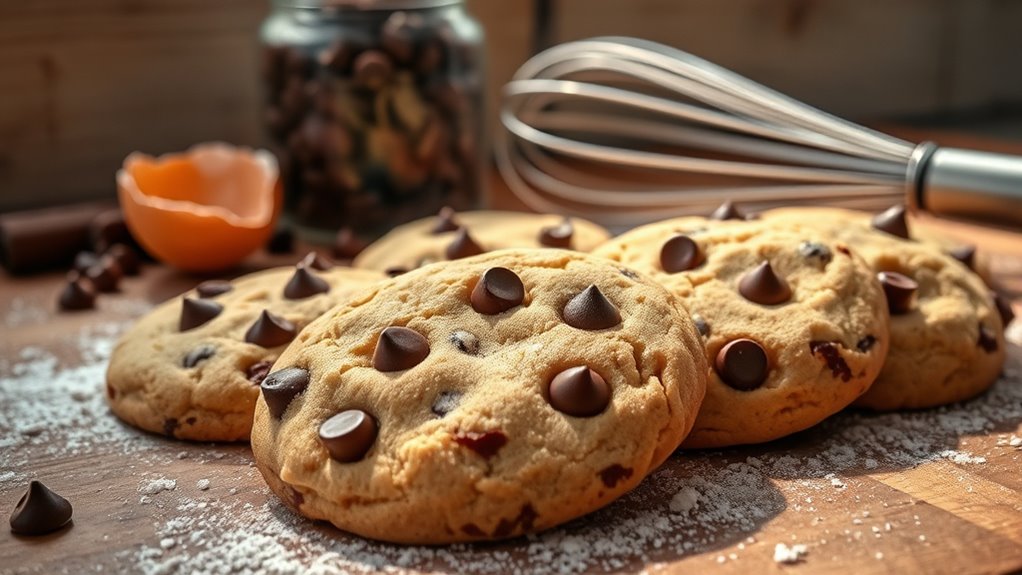You’ll want to start with 240g sifted flour, 170g softened butter, and 150g sugar for balanced sweetness and texture. Cream butter and sugar until fluffy, add eggs and vanilla, then gently fold in sifted dry ingredients and chocolate chips to maintain aeration. Portion dough with space on sheets to control spread. Bake precisely for even rising and ideal browning. Serve cooled alongside milk or coffee to enhance flavor. Keep going to uncover key tips for perfect cookies every time.
Ingredients and Quantity

The foundation of any successful chocolate chip cookie lies in selecting the right ingredients and measuring them accurately. You need to take into account chocolate types—semisweet, bittersweet, or milk chocolate—each affecting texture and sweetness differently. Measuring accuracy guarantees consistent results, so use a digital scale for dry and wet ingredients. Below is a precise guide to essential ingredients and their quantities:
| Ingredient | Quantity | Notes |
|---|---|---|
| All-purpose flour | 240 grams | Sifted for aeration |
| Unsalted butter | 170 grams | Room temperature |
| Granulated sugar | 150 grams | For sweetness and crispness |
Preparations

Now that you have your ingredients measured with accuracy, it’s important to focus on preparing them properly to guarantee ideal mixing and baking performance. Begin by confirming your butter is at the right temperature—softened but not melted—to facilitate emulsification when creamed with sugars. Sift dry components like flour, baking soda, and salt to eliminate lumps and distribute leavening agents evenly. When incorporating eggs, crack them into a separate bowl to avoid shell fragments and confirm freshness. For the chocolate chips, measure precisely; uneven distribution impacts the cookie dough’s texture. These preparations optimize the chemical reactions during baking, affecting rise, spread, and crumb structure. Mastering these baking techniques allows you the freedom to experiment confidently, confirming consistent cookie dough quality and perfect chocolate chip cookies every time.
How to Prepare

- Cream the softened butter and sugars together until the mixture is light and fluffy, ensuring proper incorporation of air for ideal cookie texture.
- Gradually add eggs and vanilla extract, mixing just until combined to prevent overworking the dough.
- Incorporate dry ingredients—flour, baking soda, and salt—using gentle folding techniques to maintain dough aeration.
- Stir in chocolate chips evenly, distributing them without excessive mixing.
- Use standardized mixing techniques for consistent results.
- Portion dough onto prepared baking sheets, spacing adequately to accommodate spread.
- Adhere strictly to recommended baking times, typically 10–12 minutes at 350°F, monitoring for golden edges and soft centers.
- Remove promptly to halt cooking and preserve best texture.
- Follow these precise steps to control final cookie characteristics, supporting your baking freedom with reliable methodology.
How to Serve

One effective way to serve chocolate chip cookies is at room temperature, allowing their texture and flavor to fully develop. For ideal cookie presentation, arrange them on a non-reflective, matte-finished plate to minimize glare and highlight their rich color. Serving suggestions include pairing cookies with a chilled glass of milk or a warm cup of coffee to balance sweetness and enhance aromas. If you want to add variety, consider stacking cookies in a staggered formation or placing them alongside fresh fruit for contrast. Avoid overcrowding the serving surface to maintain visual appeal and ease of selection. By controlling temperature and presentation, you guarantee each cookie delivers maximum enjoyment while maintaining freedom in how you customize the experience.
Tips

Serving chocolate chip cookies with attention to temperature and presentation sets the stage, but mastering the baking process itself requires specific techniques. You’ll want to chill your dough to solidify fats, which controls spread and texture. Use precise measurements of leavening agents—too much baking soda alters rise and flavor. Rotate your baking sheet midway for even heat distribution. Experimenting with cookie variations like adding nuts or using different chocolate types lets you tailor texture and taste without compromising structure. Always preheat your oven to the exact temperature; fluctuations affect the Maillard reaction and crumb. Avoid overmixing to prevent gluten overdevelopment, which toughens cookies. These baking techniques grant you control and freedom to perfect your cookies every time.
Food Value and Benefit
Chocolate chip cookies, while primarily enjoyed as a sweet treat, offer certain nutritional values and benefits when consumed in moderation.
Food Value of Prepared Dish:
- Rich in carbohydrates and sugars, providing a quick source of energy.
- Contains fats from butter and chocolate chips, contributing to satiety and flavor.
- Provides small amounts of dietary fiber, especially if whole wheat flour is used.
- Supplies trace amounts of vitamins and minerals including Vitamin A (from butter), Iron (from chocolate chips), and small quantities of calcium and magnesium.
Benefits of Eating This Recipe:
- Provides an immediate energy boost due to carbohydrate content.
- Contains antioxidants from chocolate chips that may support overall health.
- Fats from butter aid in the absorption of fat-soluble vitamins.
- Can be modified to enhance nutritional content by incorporating whole grain flours and reducing added sugars.
- Offers a satisfying treat that can support mental well-being and enjoyment when consumed mindfully.
Understanding these aspects allows you to enjoy chocolate chip cookies as part of a balanced diet while appreciating their role in energy provision and occasional indulgence.
